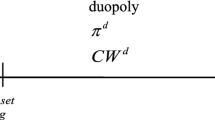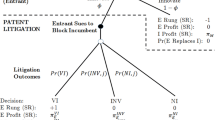Abstract
We argue that, in the pharmaceutical industry, excessive patent duration can deter investments in innovative treatments in favor of me-too drugs. The point is that too-long durations foster incentives to collude to delay investments in R&D for innovative treatments. We give a set of sufficient conditions for which collusion is a subgame-perfect equilibrium; that is, the threat of punishing any deviator is credible. We then show that reducing current duration always breaks down market discipline, and so does an increase in duration for innovative treatments. Optimal patent duration must then be a trade-off between breaking down market discipline and rewarding innovation.
Similar content being viewed by others
References
American Pharmaceutical Research Companies. (2007). Pharmaceutical researchers are testing 92 medicines and vaccines for HIV and related conditions. Report on Medicines in Development for HIV/AIDS.
Bain, J. (1956). Barriers to new competition. Cambridge, MA: Harvard University Press.
Bernheim, D., & Whinston, M. D. (1990). Multimarket contact and collusive behavior. RAND Journal of Economics, 21, 1–26.
Borrell, J.-R. (2007). Pricing and patents of HIV/AIDS drugs in developing countries. Applied Economics, 39, 505–518.
Chamberlin, E. (1933). Theory of monopolistic competition. Cambridge, MA: Harvard University Press.
Cornelli, F., & Schankerman, M. (1999). Patent renewals and R&D incentives. The RAND Journal of Economics, 30, 197–213.
Denicolo, V. (1999). The optimal life of a patent when the timing of innovation is stochastic. International Journal of Industrial Organization, 17, 827–846.
Ganuza, J., Llobet, G., & Domnguez, B. (2009). R&D in the pharmaceutical industry: A world of small innovations. Management Science, 55, 539–551.
Gonzalez, P., Macho-Stadler, I., & Perez-Castrillo, D. (2015). Private versus social incentives for pharmaceutical innovation. IDEAS: Working Papers, Universidad Pablo de Olavide, WP ECON 15.07.
Grabowski, H. (2003). Innovation and R&D incentives for orphan drugs and neglected diseases. Mimeo: Duke University.
Grabowski, H., & Vernon, J. (1992). Brand loyalty, entry and price competition in pharmaceuticals after the 1984 drug act. Journal of Law and Economics, 35, 331–350.
Grootendorst, P., & Di Matteo, L. (2007). The effect of pharmaceutical patent term Length on research and development and drug expenditures in Canada. Healthcare Policy, 2, 63–84.
Horowitz, A., & Lai, E. (1996). Patent length and the rate of innovation. International Economic Review, 37, 785–801.
Hudson, J. (2000). Take-up in the pharmaceutical market following patent expiry: A multi-country study. International Review of Law and Economics, 24, 103–112.
Ito, B., & Yamagata, T. (2007). Who develops innovations in medicine for the poor? Trends in patent applications related to medicines for HIV/AIDS, tuberculosis, malaria and neglected diseases. The Developing Economies, 2, 141–171.
Klausner, R. D., et al. (2003). The need for a global HIV vaccine enterprise. Science, 300, 2036–2039.
Kremer, M. (2002). Pharmaceuticals and the developing world. Journal of Economic Perspectives, 16, 67–90.
Kremer, M., & Glennerster, R. (2004). Strong medicine: Creating incentives for pharmaceutical research on neglected diseases. Princeton, NJ: Princeton University Press.
Leibowitz, A., & Sood, N. (2007). Market power and state costs of HIV/AIDS drugs. International Journal of Health Care Finance and Economics, 7, 59–71.
Leoni, P. (2010). Economic challenges in the fight against HIV/AIDS. New York: Nova Science Publishers.
Matsushima, H. (2001). Multimarket contact, imperfect monitoring, and implicit collusion. Journal of Economic Theory, 98, 158–178.
Offit, P. (2005). Why are pharmaceutical companies gradually abandoning vaccines? Health Affairs, 24, 622–630.
Sherer, F. (1980). Industrial market structure and economic performance (2nd ed.). Chicago: Rand-McNally.
Tirole, J. (1988). The theory of industrial organization. Cambridge, MA: MIT Press.
Trouiller, P. (2012). Drug development for neglected diseases: A deficient market and a public-health policy failure. The Lancet, 359, 2188–2194.
United States Government Accountability Office. (2006). New drug development: Science, business, regulatory and intellectual property issues cited as hampening drug development efforts. Report, U.S. Government Accountability Office, Washington, D.C. http://www.gao.gov/new.items/d0749.
Author information
Authors and Affiliations
Corresponding author
Appendices
Appendix 1: Computation of \(\theta ^{i}\)
When both firms try to develop the vaccine the payoff for firm i is:
where the first term correspond to the case when firm i is successful: with probability \(\alpha \) firm j is also successful, hence they share the profits, and with probability \(\left( 1-\alpha \right) \) firm j is unsuccessful, hence firm i get all the profits. The second term correspond to the case in which both firms are unsuccessful. In this case, firm i will enjoy the profits from his patents and will play the same game in the next period because the unsuccessful vaccine produces another patent on drugs. If only firm j is successful, firm i gets nothing. Whether firm i is successful or not it has to pay the cost C. Solving for \(\theta ^{i}~\)gives:
Appendix 2: Proof of Proposition 1
Suppose both firms play the Collusion Strategy. Then, the payoff to each is \(\frac{CF_{p}^{i}}{1-\beta }\). Suppose a firm uses another strategy. This must involve researching drugs for a number of periods (maybe zero) and then researching a vaccine until the game ends. This is optimal since the other firm is playing a Collusion Strategy, hence the other firm will play v forever and, as A3 hold, the best response for firm i is to play v. Consider the game at \(t=0~\)without loss of generality. If firm i plays v, it receives \(\left[ \alpha CF_{v}+\left( 1-\alpha \right) \theta ^{i}-C\right] \). Hence, the Collusion Strategy is an equilibrium if and only if \(\frac{CF_{p}^{i}}{1-\beta }\,\ge \left[ \alpha CF_{v}+\left( 1-\alpha \right) \theta ^{i}-C\right] \).
Rights and permissions
About this article
Cite this article
Leoni, P., Sandroni, A. Can patent duration hinder medical innovation. Int J Health Econ Manag. 16, 397–406 (2016). https://doi.org/10.1007/s10754-016-9198-0
Received:
Accepted:
Published:
Issue Date:
DOI: https://doi.org/10.1007/s10754-016-9198-0




